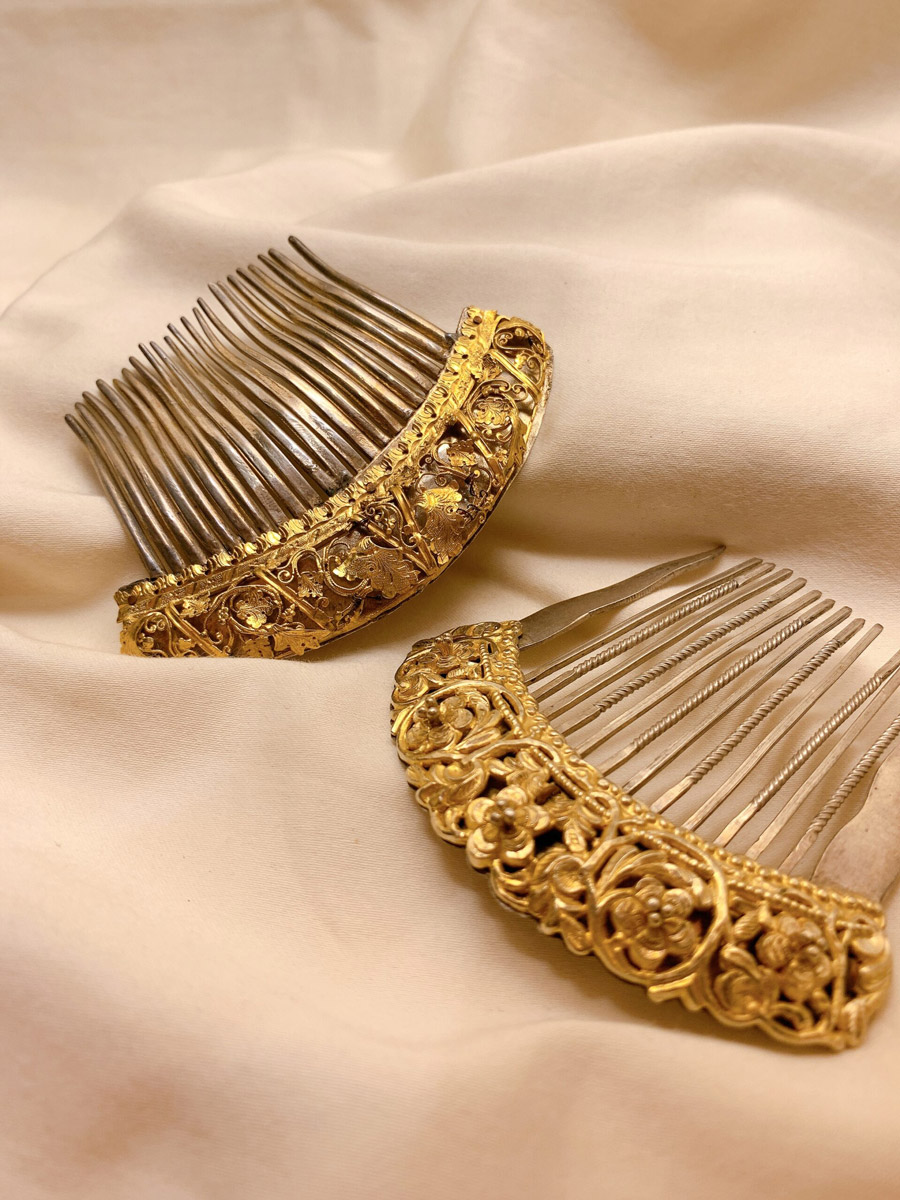Long, straight, jet-black, and adorned with gold. History books are filled with accounts depicting the hair of the early Filipinas—a fitting canvas for the striking pieces of jewelry that adorned these dark tresses then and well-throughout the colonial years.
Among the most iconic of the hair ornaments worn by Filipinas during the Spanish colonial era was the payneta (or peineta)—a decorative comb made of tortoise shells, silver, or gold, often with highly intricate embellishments in precious metal or jewels.
The payneta is said to have originated from 19th century Spain as evidenced by the use of similar ornaments in areas with heavy Hispanic influence such as the Southwest of the United States, Puerto Rico, Mexico, and Cuba. However, decorative combs have also long been a staple throughout ancient Asia, and were already heavily traded across the region, perhaps allowing the easy acceptance of the payneta into early Spanish-colonial Philippines.
While its use is by all means ornamental, the popularity of the payneta began with a more practical and even religious intent—to help keep a woman’s veil in place while she is at church. At the time, the Catholicism brought by the Spanish conquistadors was far more conservative, and the friars were quick to encourage this, ensuring that female mass-goers were appropriately and sufficiently covered-up—veil and all. In no time, ingenuous Filipino artisans began to put their own distinctive marks on the paynetas (and even hairpins) that adorned the heads of the piously veiled.
The payneta thus became a thing of beauty, a must-wear for the who’s who in society—so much so that it would be worn ornamentally and every day sans veil. The articulated hair comb could be styled easily, allowing the user to bend or twist its delicate gold or silver parts against the hair. Matching sets of paynetas, earrings, and necklaces also became in vogue, with families often buying plain horn and tortoise shell combs from Chinese traders, so they could adorn these with silver, gold, or stones to match their jewelry.
A melting pot of influences, the Philippine payneta soon took on its own distinct aesthetic. While its Spanish roots were prevalent, the designs of the local payneta bore a wholly unique Eurasian flavor. Prior to the conquistadors, the predominantly Islamic Philippines was already known as a regional trading point for gold thanks to its highly skilled goldsmiths. That meant even before the influx of European styles, the locals had already acquired a mastery of Islamic, Malay, and other Asian artistry, which had now knowingly or unknowingly begun to integrate with the new Western tastes.
Many paynetas are a testament to this, bearing such dual elements as Malayo-Chinese embroidery-like patterns and European florals hammered into the gold sheets. Local goldsmiths who learned the fine art of European-inspired tamborine beads (very fine, hollow, gold-filigree beads) also took native flora as inspiration, placing elaborate shapes on hair combs similar to the kamatsile (tamarind), sampaguita, and pineapple, to name a few.
An ever-evolving reminder of our rich cultural heritage, paynetas have become more than an object of Spanish influence. They are an artform that carries a deeper history, allowing us to delve even into our pre-colonial past. While the payneta may no longer adorn the heads of many modern-day Filipinas, they remain highly prized, family heirlooms because of their history and the artistry that can often no longer be replicated.
Today, however, there is a silent but steady resurgence to bring back what makes us uniquely Filipino. From heritage jewelry to resurfacing traditional techniques—including that of the delicate payneta—ingenuous Filipinos are once again finding new ways to wear treasured heirlooms. Whether it’s an original payneta repurposed as a necklace, or using old payneta techniques to make contemporary jewelry, there seems to be a new, collective goal to evolve and yet still conserve our traditions.
Through these payneta designs so carefully etched and hammered by hand, we learn about who we were, what we’ve been through, and how we’ve become stronger as a people—strengthening our identity well into the future.
References:
Laxina, Ben A., and Felice Sta. Maria. “Needlework, Adornments and Toiletries.” Household Antiques & Heirlooms, edited by Gilda Cordero-Fernando. CGF Books, 1983.
Mieri, Magdalena. “Peinetones: High combs, high fashion.” National Museum of American History, 5 May 2014, americanhistory.si.edu/blog/2014/05/peinetones-high-combs-high-fashion.html.
Villegas, Ramon N. “Pride and Power.” Kayamanan: The Philippine Jewelry Tradition. The Central Bank of the Philippines, 1983.
